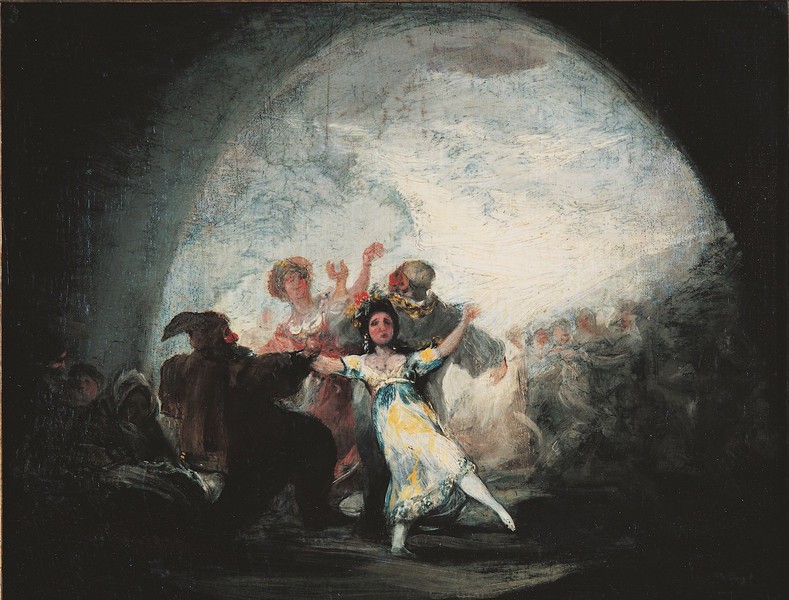- Cronología
- Ca. 1808 - 1820
- Ubicación
- Museo Goya. Colección Ibercaja, Zaragoza, Spain
- Dimensiones
- 30 x 38 cm
- Técnica y soporte
- Oil on canvas
- Reconocimiento de la autoría de Goya
- Undisputed work
- Titular
- Ibercaja Collection
- Ficha: realización/revisión
- 28 Apr 2010 / 15 Jun 2023
- Inventario
- (1173)
- Otros títulos:
-
Masked Ball under an Arch (Baile de máscaras bajo un arco)
The work belonged to the collection of Valentín Carderera. It appeared in an inventory of his collection with the number 226, group C (small format paintings), under the following entry: A dance featuring various men and women under a bridge arch, etcetera. Original painting by Goya, width: one and a half hands. 500 [reales]. On the death of Carderera in 1880, it moved to the collection of the Duke of Villahermosa, having first been installed in the Villahermosa Palace in Madrid and later in the Duke's Palace at Pedrola in Zaragoza. In March of 1996 it was bought by Ibercaja along with the sketch Second of May 1808.
The composition is dominated by a large arch which allows the light to penetrate, leaving the upper corners of the picture in total shadow. Under the arch we can see a group of masked figures dancing. In the centre of the canvas, a girl dressed in a yellow dress raises her arms and left leg as she makes a dance move reminiscent of the Aragonese jota (folk dance). Another three figures dance with her. On the left, sheltering under the arch, three humble-looking characters are sitting, ignoring the dance being performed by those in front of them, thus creating a great contrast between the poses of the two groups of figures.
The theme of masks makes an appearance in various works by Goya, a noteworthy example being The Burial of the Sardine, in which the painter reveals his vision of an irrational society to the viewer. Perhaps he wanted to express his perplexity before a people imbibed with the most macabre traditions.
The brushstrokes used for this tiny painting are notable for their thickness, and they are especially visible in illuminated areas such as the light of the arch and the clothing of the central figure.
-
Francisco de Goya. IV Centenario de la capitalidadorganized by Ayuntamiento de Madrid and Dirección General de Bellas Artes at the Casón del Buen RetiroMadrid1961consultant editor Valentín de Sambricio
-
Goya 1900Ministerio de Instrucción Pública and Bellas ArtesMadrid1900consultant editors Aureliano de Beruete, Alejandro Ferrant, Marqués de Pidal and Ricardo Velázquez. May 1900cat. 73
-
Pinturas de GoyaMuseo Nacional del PradoMadrid1928consultant editor Fernando Álvarez de Sotomayor. From April to May 1928cat. 53
-
Exposición de bocetos para pinturas y esculturas (Siglos XVI-XIX)Sociedad Española de Amigos del ArteMadrid1949cat. 84
-
GoyaFestival Internacional de Granada, Palacio de Carlos VGranada1955consultant editor Enrique Lafuente Ferraricat. 109
-
Goya en las colecciones madrileñasMuseo Nacional del PradoMadrid1983consultant editor Enrique Lafuente Ferrari. From April 19th to June 20th 1983cat. LVIII
-
Du Greco á Goya: chefs-d’œuvre du Musée du Prado et des collections espagnolesGeneva1989Musée d’Art et D’Histoirecat. 42
-
De Goya al cambio de siglo (1800-1920). Pintura española y europea en la Colección IbercajaMuseu d’Art Jaume MoreraLérida2001organized by Obra social y cultural de Ibercaja at the following venues: Museo de Belas Artes da Coruña, A Coruña; Museo de Teruel; Museo de Huesca, Sala Amós Salvador de Logroño and Museo de Guadalajara, September 6th 2001 to March 10th 2002, consultant editor Ricardo Centellas Salamero.cat. 3
-
Goya e il Mondo ModernoPalazzo RealeMilan2010organized by SEACEX, Palazzo Reale and Fundación Goya en Aragón, consultant editors Valeriano Bozal and Concepción Lomba Serrano. From March 17th to June 27th 2010cat. 40
-
Madrid2017
-
L'œuvre peint de Goya. 4 volsParís1928-1950vol, I, p. 264, cat. 239
-
Inventario de las pinturas de la colección de don Valentín CardereraArchivo Español de ArteMadrid1965p. 223, nº 266
-
Vie et ouvre de Francisco de GoyaParísOffice du livre1970pp. 256, 267, cat. 972
-
BarcelonaPolígrafa1970vol. I, p. 321, cat. 468
-
L’opera pittorica completa di GoyaMilanRizzoli1974p. 126, cat. 552
-
Francisco de Goya, 4 vols.ZaragozaCaja de Ahorros de Zaragoza, Aragón y Rioja1980-1982vol. III, p. 167
-
De Goya al cambio de siglo (1800-1920) : pintura española y europea en la Colección IbercajaLéridaIbercaja2001p. 50, cat. 3 y pp. 52-53 (il.)
-
ZaragozaGobierno de Aragón y Fundación Bancaria Ibercaja2017p. 207
